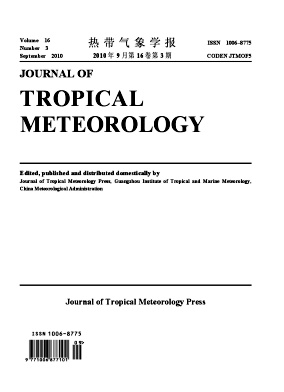-
Abstract:
This study examines the wave trains at 500 hPa occurring in East Asian summer by using the Empirical Orthogonal Function (EOF) analysis as a diagnostic tool. The results are summarized as follows: (1) A wave train pattern (OKJ pattern) originating from the upstream areas of the Sea of Okhotsk to the subtropical regions could display its strong signal in early and middle summer. The OKJ pattern is clearly recognized in the first EOF component in Eurasia. (2) The other wave train pattern originating from the Philippines via Japan to North America (the P-J pattern) shows quite strong signals in the whole summer. Although the P-J pattern is described as the second EOF component around the area from East Asia to Northeast Pacific Ocean, the variance contribution is the same as that of OKJ pattern in the first EOF component. (3) The composite analyses indicate that the OKJ and P-J wave trains could coexist to some extents.
-
References
|
[1]
|
WALKER G T, BLISS E W. World weather [J]. V Mem. RMeteor. Soc., 1932, 4(2): 53-84. |
|
[2]
|
WALLACE J M, GUTZLER D S. Teleconnection in thegeopotential height field during the Northern Hemispherewinter [J]. Mon. Wea. Rev., 1981, 109(4): 784-812. |
|
[3]
|
HOSKINS B J, KAROLY D J. The steady linear responseof a spherical atmosphere to thermal and orographic forcing [J].Atmos. Sci., 1981, 38(6): 1 179-1 196. |
|
[4]
|
WANG Y. Effects of blocking anticyclones in Eurasia in therainy season (Meiyu/Baiu season) [J]. J. Meteor. Soc. Japan,1992, 70(5); 929-951. |
|
[5]
|
KATO K. The synoptic features about the Okhotsk highrelated to YAMASEI [R]// KISHOU-KENKYU(Meteorological Research) Note, Tokyo: MeteorologicalSociety of Japan, 1995, 183: 67-69. |
|
[6]
|
NAKAMURA H, et al. The evolution of blocking and itsdynamics related with the formation of Okhotsk high [R]//KISHOU-KENKYU (Meteorological Research) Note, Tokyo:Meteorological Society of Japan, 1997, 189: 177-190. |
|
[7]
|
OGI M, TACHIBANA Y, YAMAZAKI K. The connectivityof the winter North Atlantic oscillation (NAO) and thesummer Okhotsk High [J]. J. Meteor. Soc. Japan, 2004, 82(3):905-913. |
|
[8]
|
NITTA T. Convective activities in the tropical westernPacific and their impact on the northern hemisphere summercirculation [J]. J. Meteor. Soc. Japan, 1987, 65(3): 373-390. |
|
[9]
|
HUANG R H, LI W J. Influence of the heat source anomalyover the western tropical Pacific on the subtropical high overEast Asia [C]// Proc. International conference on the generalcirculation of East Asia (Tokyo), 1987: 40-51. |
|
[10]
|
PlUMB R A. On the three dimensional propagation ofstationary waves [J]. J. Atmos. Sci., 1985, 42: 217-229. |
|
[11]
|
OVERLAND J E, PREISENDORFER R W. Asignificance test for principal applied to a cyclone climatology[J]. Mon. Wea. Rev., 1982, 110(1): 1-4. |
|
[12]
|
WANG Y, YASUNARI T. A diagnostic analysis of thewave train propagating from high-latitudes to low-latitudes inearly summer [J]. J. Meteor. Soc. Japan, 1994, 72(2): 269-279. |
|
[13]
|
WANG Y, WANG B, OH J H. Impact of the preceding ElNino on the east Asian Summer Atmospheric Circulation [J]. J.Meteor. Soc. Japan. 2001. Vol.79. No.1B: 575-588. |
|
[14]
|
WANG Y, FUJIYOSHI Y, KATO K. A teleconnectionpattern related with the development of the Okhotsk high andthe northward progress of the subtropical high in East Asiansummer [J]. Adv. Atmos. Sci., 2003, 20(2): 237-244. |
|
[15]
|
WANG Ya-fei, TAKAHASHI K. Decadal climatevariability of rainfall around the middle and lower reaches ofthe Yangtze River and atmospheric circulation [J]. J. Trop.Meteor. (in Chinese), 2005. 21 (4): 351-358. |
-
-
-

















 粤公网安备 4401069904700002号
粤公网安备 4401069904700002号
 DownLoad:
DownLoad: